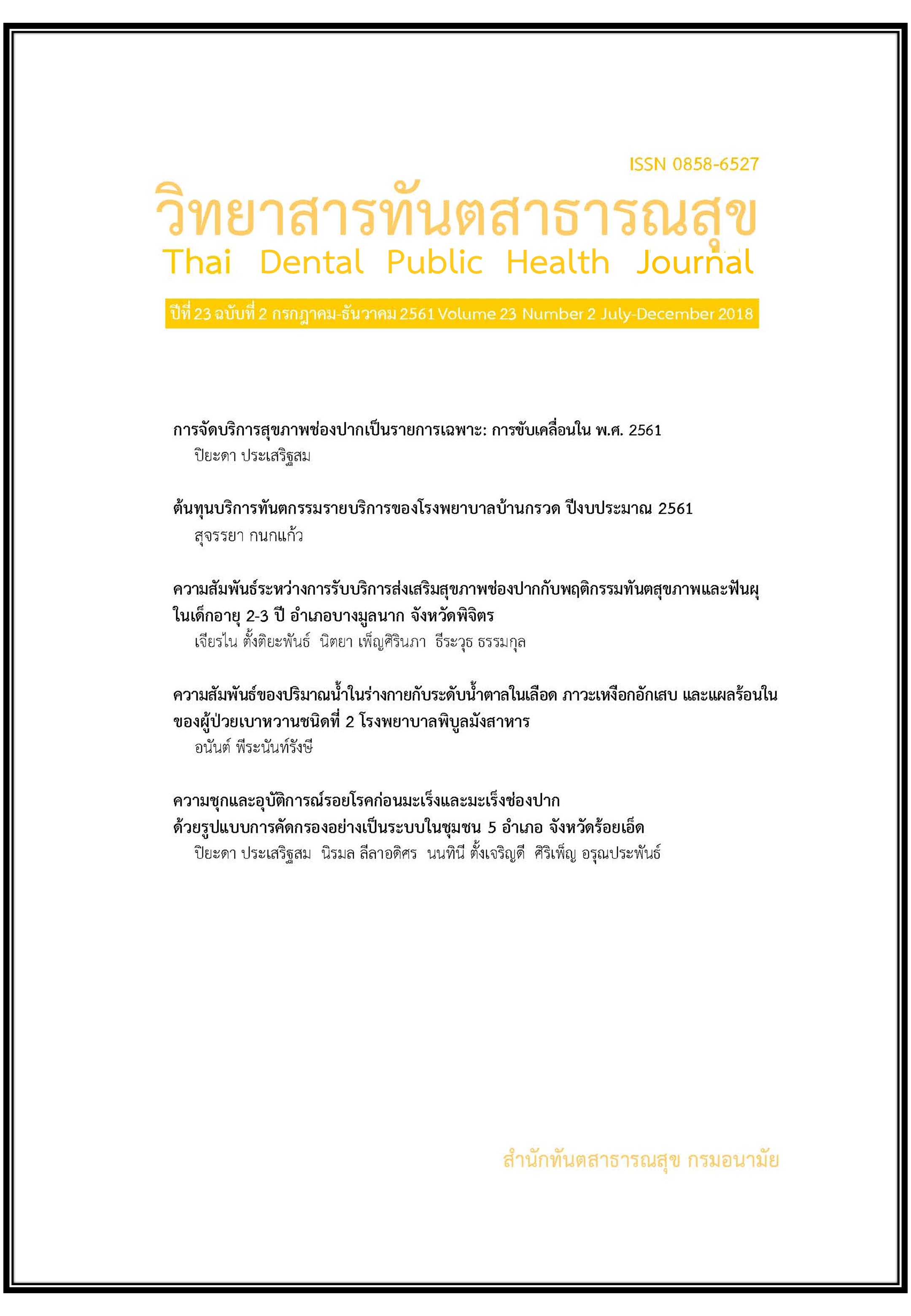Relationship among total body water and fasting blood sugar, gingival status, and aphthous ulcer in type 2 diabetic patients at Phiboon Mangsahan Hospital.
Main Article Content
Abstract
This observational research aimed to study correlations between body water and blood sugar levels, gingivitis conditions, and recurrent aphthous ulcer among type 2 diabetes patients at Phiboon Mangsahan Hospital. The 109 patients were divided into normal and low levels of body water groups of 56 and 53 patients, respectively. Four data sets collected were body weight, blood pressure, blood sugar level, and gingival status during October-December 2018 then analyzed by Pearson's correlation and multinomial logistics regression.
The body water level was very low negatively correlated with blood sugar level (r=-0.22, p= 0.02) and low negatively correlated with gingival index (r= -0.33, p= 0.00). The gingival index was very low positively correlated with blood sugar level (r= 0.22, p= 0.02). The low body water level group was found diabetes-blood sugar level and moderate gingivitis 3.73 and 8.70 times of the normal body water group (95% CI= 1.52-9.14, p-value= 0.00 and 95% CI= 2.56-29.54, p-value= 0.00; respectively). Therefore body water levels was inversely correlated with blood sugar levels and gingivitis. The aphthous ulcer was not correlated with body water level, blood sugar level, and severity of gingivitis.
Downloads
Article Details
References
2. International Diabetes Federation. IDF diabetes atlas 8th edition. 2017. [cited 2018 Oct 16]; Available from: URL:https://www. worlddiabetesfoundation.org/sites/default/files/Atlas-8e-regional-fact-sheet-18-99-WP.pdf
3. LeMone P, Burke K.M. Nursing care of clients with urinary tract disorders. In LeMone P, Burke KM. (eds.), Medical-surgical nursing: Critical thinking in client care. Menlo Park, CA: Addison-Wesley 1996. p. 906-18.
4. Kessin J, Wiruchagool P, Lonil A. Self-manage-ment, knowledge, quality of life in new cases with type II diabetes mellitus, pre-post type II diabetes patients self-management program in urban areas, Uthaithani Province. Journal of Nursing Division 2013; 40(1): 84-103.
5. Moore PA, Orchard T, Guggenheimer J, Weyant RJ. Diabetes and oral health promotion: a survey of disease prevention behaviors. JADA 2000; 131(9): 1333-41. DOI:10.14219/ jada.archive.2000.0388
6. Thorstensson H, Falk H, Hugoson A, Olsson J. Some salivary factors in insulin-dependent dia-betics. Acta Odontol Scand 1989; 47(3): 175-83. DOI:10.3109/00016358909007698
7. Sreebny LM, Yu A, Green A, Valdini A. Xero-stomia in diabetes mellitus. Diabetes Care 1992; 15(7): 900-4. DOI:10.2337/diacare.15.7.900
8. Shlossman M, Knowler WC, Pettitt DJ, Genco RJ. Type 2 diabetes mellitus and periodontal disease. JADA 1990; 121(4): 532-6. DOI:10.14219/ jada.archive.1990.0211
9. Harrison R, Bowen WH. Flow rate and organic constituents of whole saliva in insulin-dependent diabetic children and adoles-cents. Pediatr Dent 1987; 9(4): 287-91.
10. Watson WS, Sammon AM. Body composition in cachexia resulting from malignant and non-malignant diseases. Cancer 1980; 46(9): 2041-6.
11. World Health Organization. Definition, diagnosis and classification of diabetes mellitus and its complications: report of a WHO consul-tation. Part 1, Diagnosis and classification of diabetes mellitus 1999; WHO. p. 48-52.
12. Löe H. The gingival index, the plaque index and the retention index systems. Periodontol 1967; 38(6) sup: 610-6. DOI:10.1902/jop.1967. 38.6.610
13. Akintoye SO, Greenberg MS. Recurrent aphthous stomatitis. Dent Clin North Am 2014; 58(2): 281–97. DOI:10.1016/j.cden.2013.12.002
14. Burge MR, Garcia N, Qualls CR, Schade DS. Differential effects of fasting and dehydration in the pathogenesis of diabetic ketoacidosis. Metabolism 2001; 50(2): 171-7. DOI:10.1053/meta.2001.20194
15. Surasehasana I.The effect of an oral health care program on changing the oral health behavior of diabetic patients at Bansok Khonsawan District, Chaiyaphum Province. Master of Public Health. Khon kaen University, Khonkaen; 2010.
16. Salekzamani Y, Shirmohammadi A, Rahbar M, Shakouri SK, Nayebi F. Association between human body composition and periodontal disease. ISRN Dent 2011; 863847. DOI:10.5402/2011/863847
17. Taylor GW, Burt BA, Becker MP, Genco RJ, Shlossman M, Knowler WC. Severe periodon-titis and risk for poor glycemic control in patients with non-insulin-dependent diabetes mellitus. J Periodontal 1996; 67: 1085-93. DOI: 10.1902/jop.1996.67.10s.1085
18. Natah SS, Konttinen YT, Enattah NS, Asham-makhi N, Sharkey KA, Hayrinen-Immonen R. Recurrent aphthous ulcers today: a review of the growing knowledge. Int J Oral Maxillofac Surg 2004; 33(3): 221-34. DOI: 10.1006/ijom. 2002.0446


